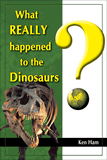
Sauropods
God’s Majestic Giants
Based on what we have found so far in the fossil record, sauropods were likely the largest family of land creatures ever to walk the earth.
Weighing as much as 100 tons (91 m. tons), they were as much as 110 ft (33 m) long1 and soared to heights of 54 ft (16.5 m). These amazing “long necks” include all the four-footed, plant-eating dinosaurs, such as Diplodocus, Brachiosaurus, and Apatosaurus. But how much do we really know about them?
Brachiosaurus (BRACH-ee-oh-SORE-us)
Its front legs were longer than its back legs. Its nostrils were located on top of the bump on its head. Length: 82 ft (25 m). Weight: 88 tons (80 m. tons).
Diplodocus (di-PLOD-oh-cuss)
This was the smallest of sauropods, largely because its bones were mostly hollow. Length: 89 ft (27 m). Weight: 10 tons (9 m. tons).
Apatosaurus (a-PAT-oh-SORE-us)
This dinosaur had a small head, tiny brain, and a large muscular tail, perhaps to ward off predators. Length: 70 ft (21 m). Weight: 30 tons (27 m. tons).
Many years ago, scientists speculated that sauropods spent most of their time in water to support their enormous weight. Evidence that seemed to support this view included their long necks and their nostrils on top of their heads. More recently, however, scientists have decided that sauropods were land-dwelling creatures. The sauropod’s anatomical structure—including its narrow feet, narrow ribcage, and reinforced backbone—is more consistent with creatures that spend most of their lives out of the water. In addition, it appears that sauropod lungs may not have been able to handle the water pressure at the required depths of 30–35 ft (9–11 m) because sustained exposure to such pressure could have collapsed their lungs and caused heart failure.
Studying sauropods is a lot like investigating a crime scene where you have only a few clues. Unable to study their lungs or hearts, our only alternative is to study their bones, compare them to living creatures, and develop models to test our theories.
Another quandary is how these dinosaurs grew so big. We know that many living reptiles and even some mammals, such as elephants, have the potential to grow slowly throughout their lifetimes. The weight of African elephants, for example, can increase from 200 lbs (91 kg) at birth to 7 tons (6 m. tons) in only 30 years. This is a 70-fold increase. The largest sauropods had a bigger challenge. One example is the Argentinosaurus. Weighing only a few pounds when it hatched, the adult Argentinosaurus later tipped the scales at about 80 tons (73 m. tons). This is about a 20,000-fold increase.
Comparing bones of juvenile dinosaurs, some scientists now believe that dinosaurs experienced rapid growth in their youth and then continued slow growth the rest of their lives. If dinosaurs lived hundreds of years, as people did before the Flood, they had plenty of time to develop into the enormous creatures we find in the fossil record. In fact, many of these dinosaurs may be the original creatures that God created on Day 6 of Creation Week.
The mysteries of dinosaurs are even greater when it comes to their origin and disappearance. “Where did dinosaurs come from?” asks The Natural History Museum Book of Dinosaurs. “That apparently simple question has been the subject of intense debate amongst scientists for over 150 years.”
Sauropods just appear and disappear in the fossil record, without connection and without explanation. According to The Complete Dinosaur, “The ancestry of the sauropods, before they burst onto the world scene on almost every continent in the Middle Jurassic, is obscure.”
No known process of change could derive them from any other known organism, and no evidence of such change is found in the fossil record.
Did You Know?
Most dinosaur names are derived from Greek and Latin.
| dino | terrible |
| saurus | lizard |
| tyranno | tyrant |
| apato | deceptive |
| seismo | earthquake |
| super | superior |
| ultra | extreme |
| brachio | arm |
| pod | foot |
| urus | tail |
| rex | king |
| veloci | speedy |
| raptor | thief |
No known process of change could derive them from any other known organism, and no evidence of such change is found in the fossil record.
Yet one source of information provides the missing clues about the origin and demise of dinosaurs—God’s eyewitness account of earth history, the Bible. It tells when all the land animals were created, and it describes the largest mass destruction of animals in earth history. Every kind of land animal was created on Day 6 of Creation Week, and God sent a Flood that wiped out every air-breathing land animal on earth, except for the few that survived on Noah’s Ark.
The Ark easily had room for the dinosaurs (as you can see in other articles in this issue). First, the Ark was the size of a huge cargo ship (at least 450 ft [137 m] long). Second, there weren’t many different kinds of dinosaurs (only about 50 “kinds”). Third, God most likely brought the smaller juvenile dinosaurs, not the aging adults, because they would be better suited for the voyage and the responsibilities of reproducing rapidly after the Flood.
While some scientists study sauropods and make evolutionary conclusions as to the origin and probable extinction of these majestic creatures, Christians must never compromise the clear teaching found in the history book of the universe, the Bible.
Answers Magazine
April – June 2007
Get a fresh look at Noah's Ark, the Global Flood and its impact on the Earth.
Browse IssueFootnotes
Recommended Resources

Answers in Genesis is an apologetics ministry, dedicated to helping Christians defend their faith and proclaim the good news of Jesus Christ.
- Customer Service 800.778.3390
- Available Monday–Friday | 9 AM–5 PM ET
- © 2025 Answers in Genesis





